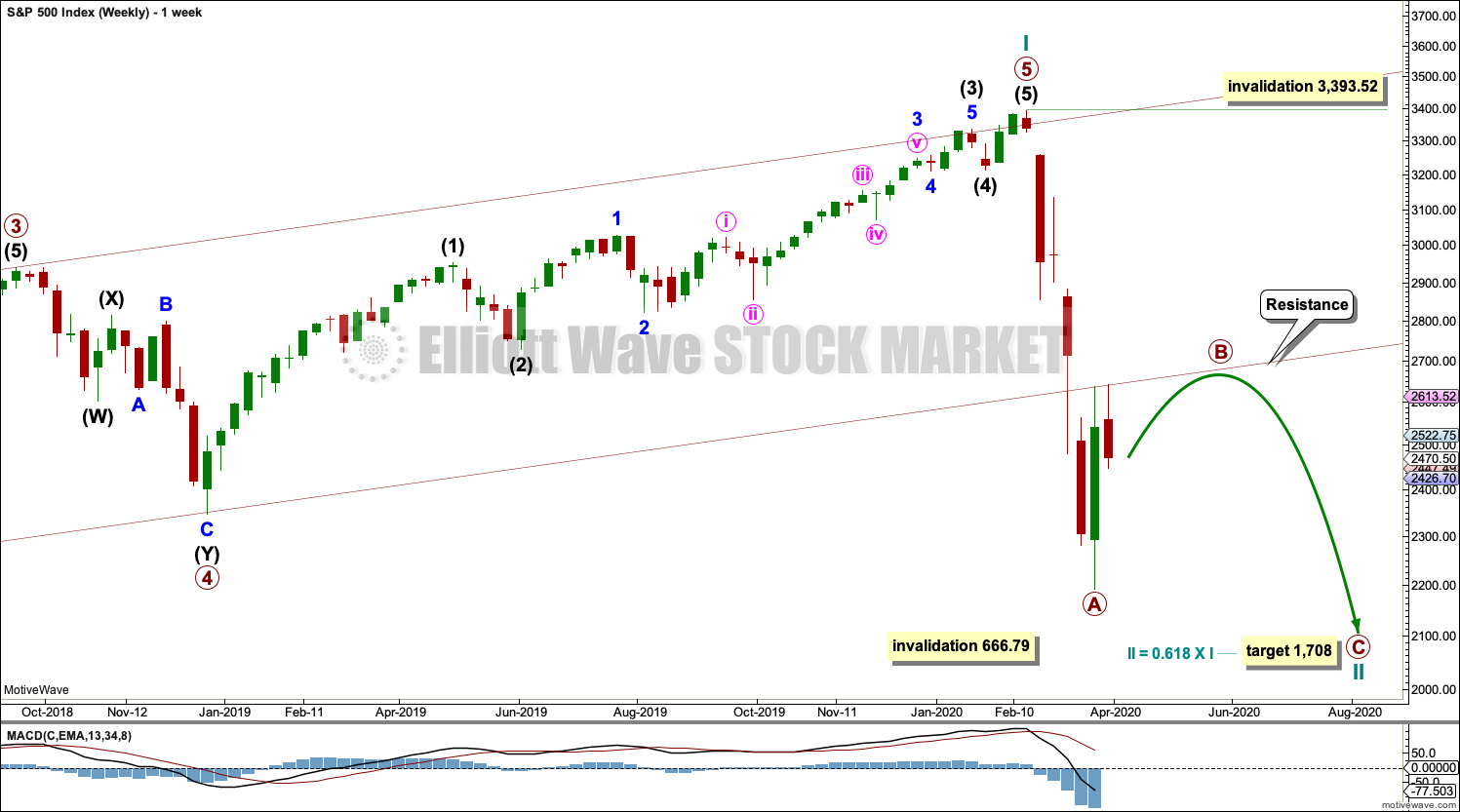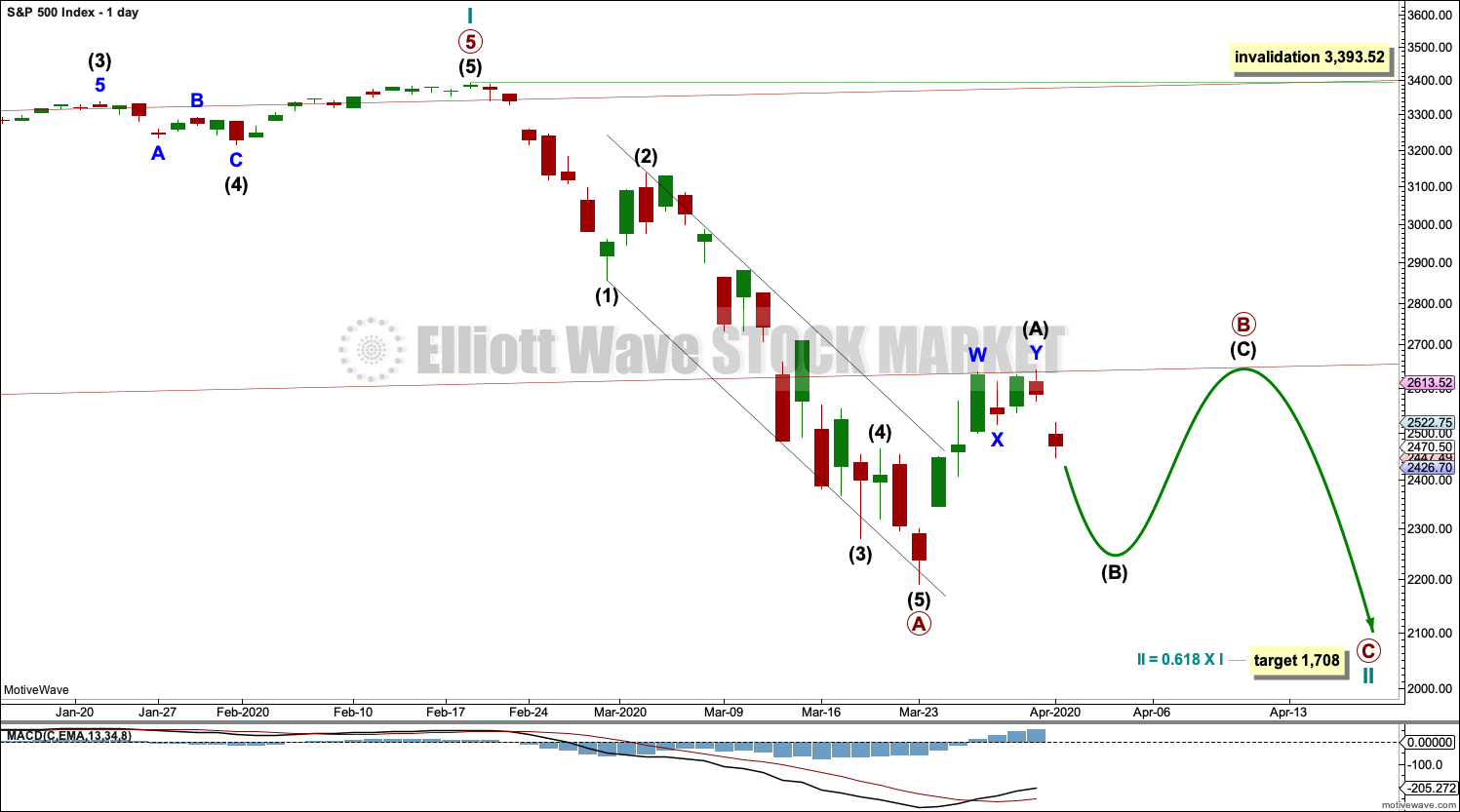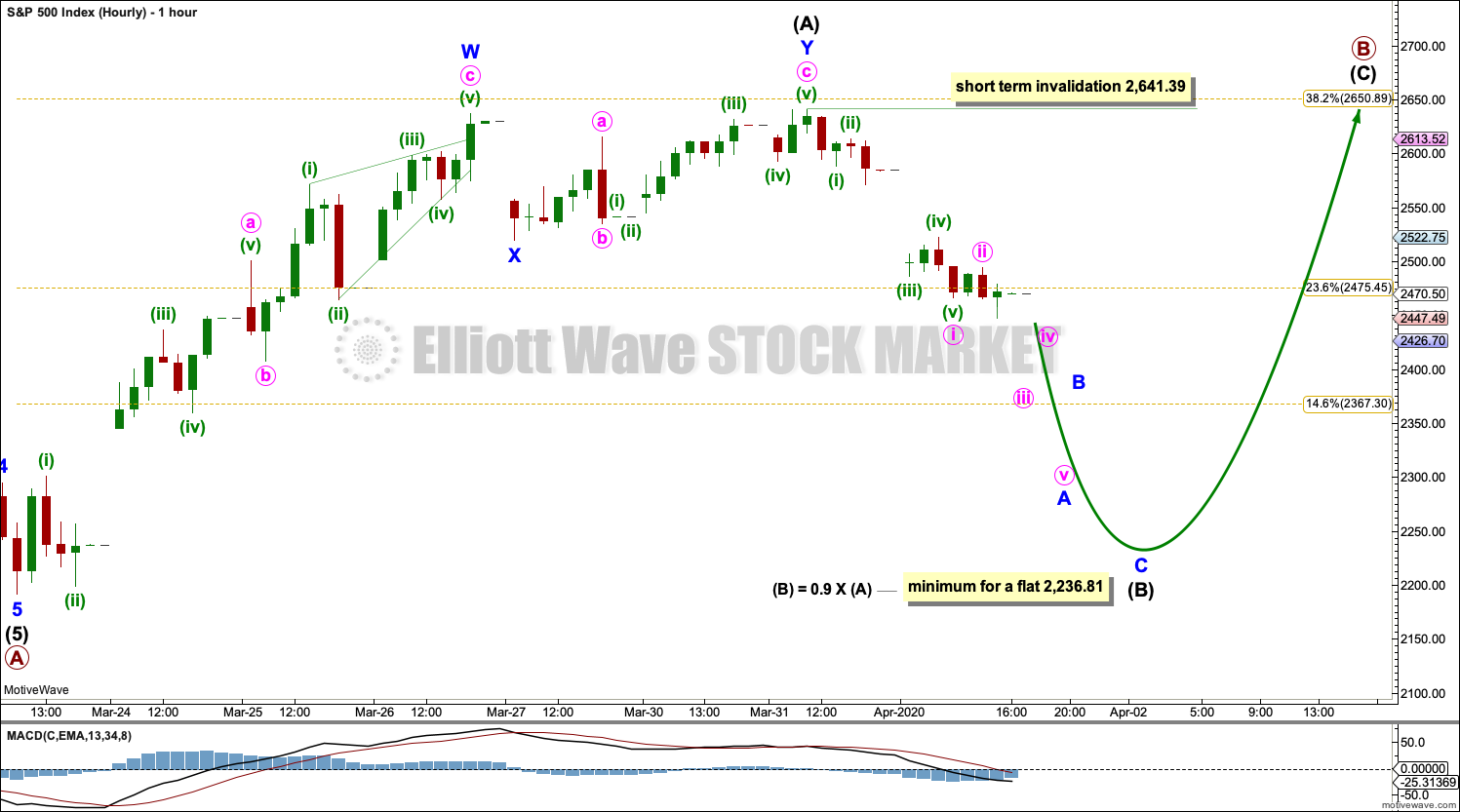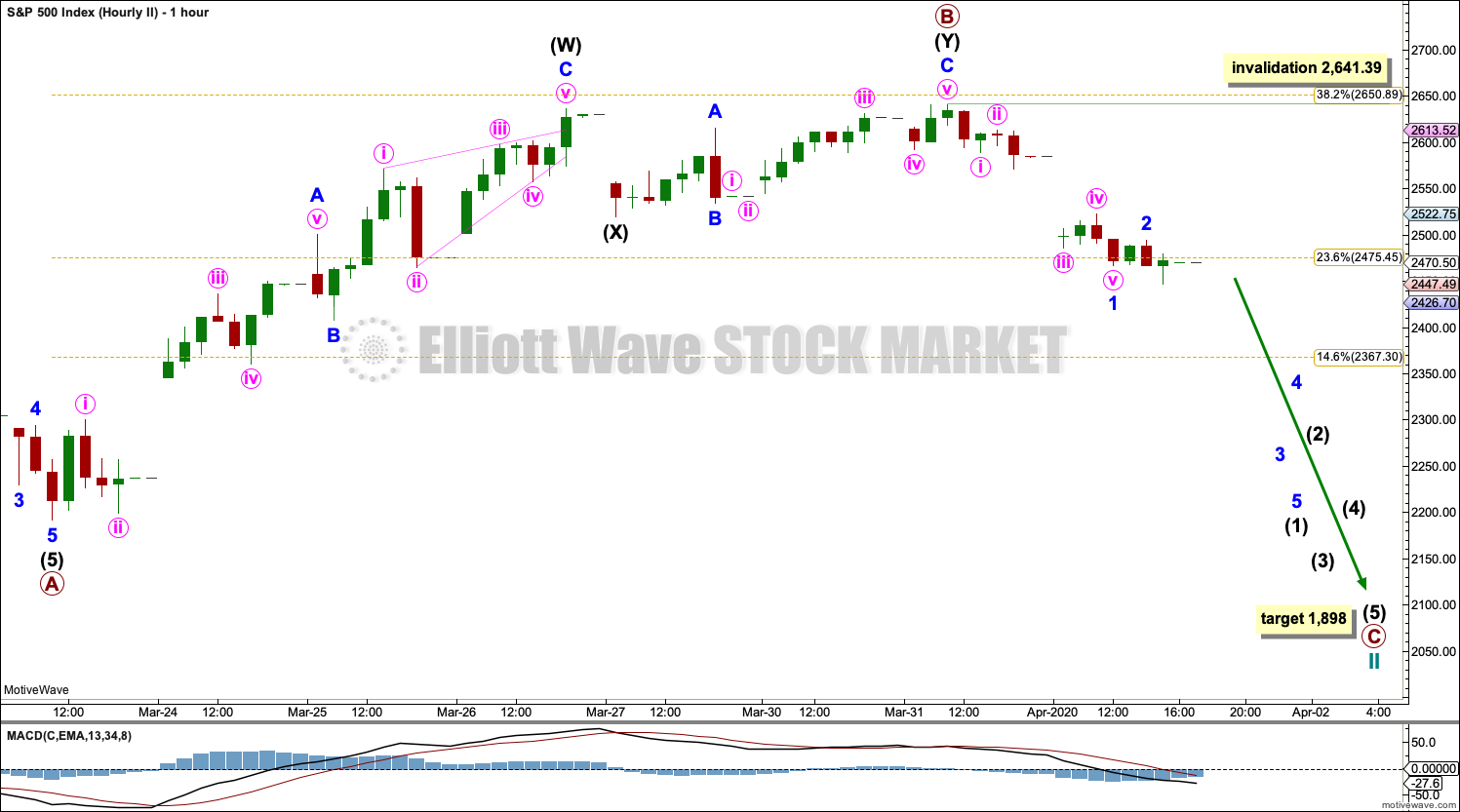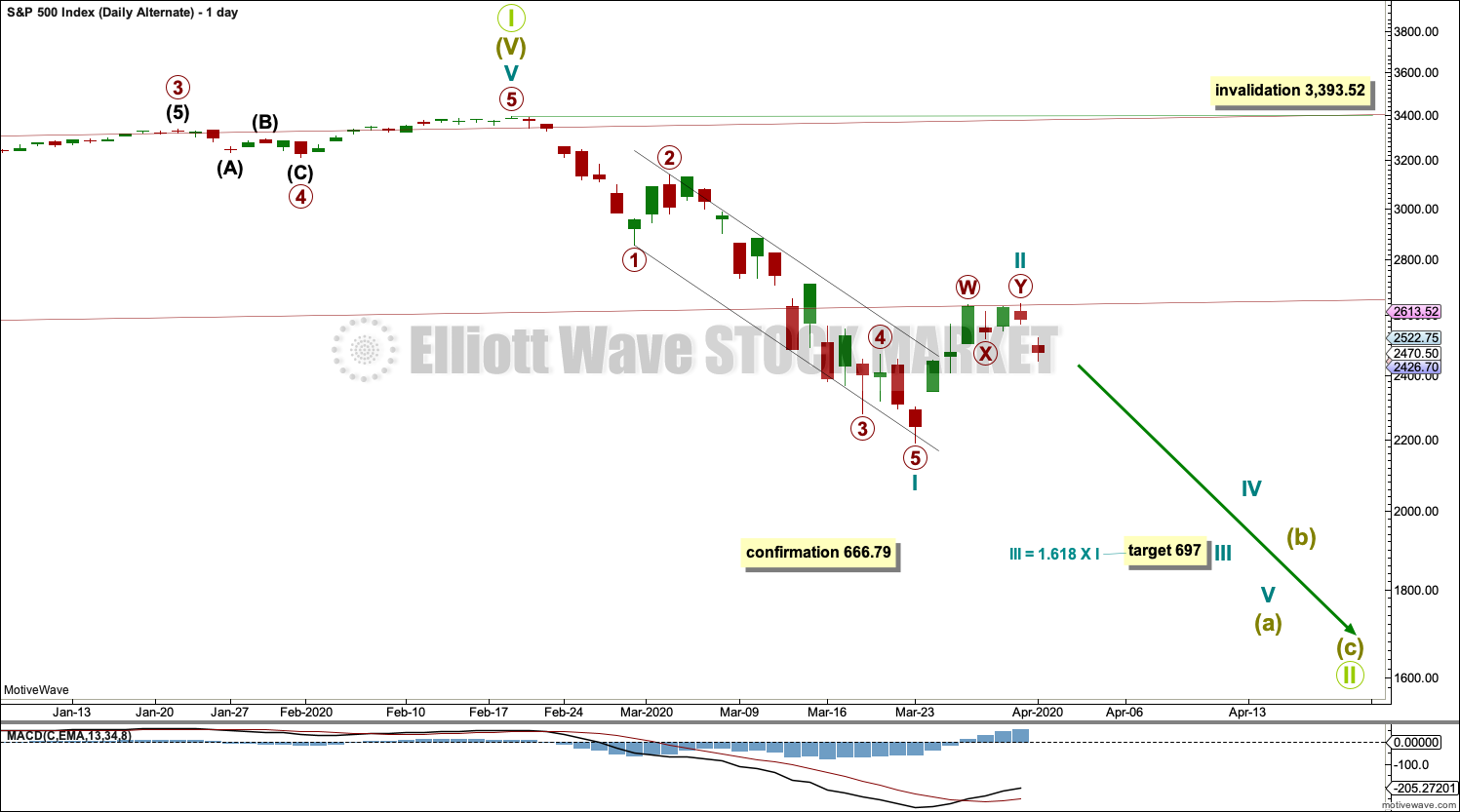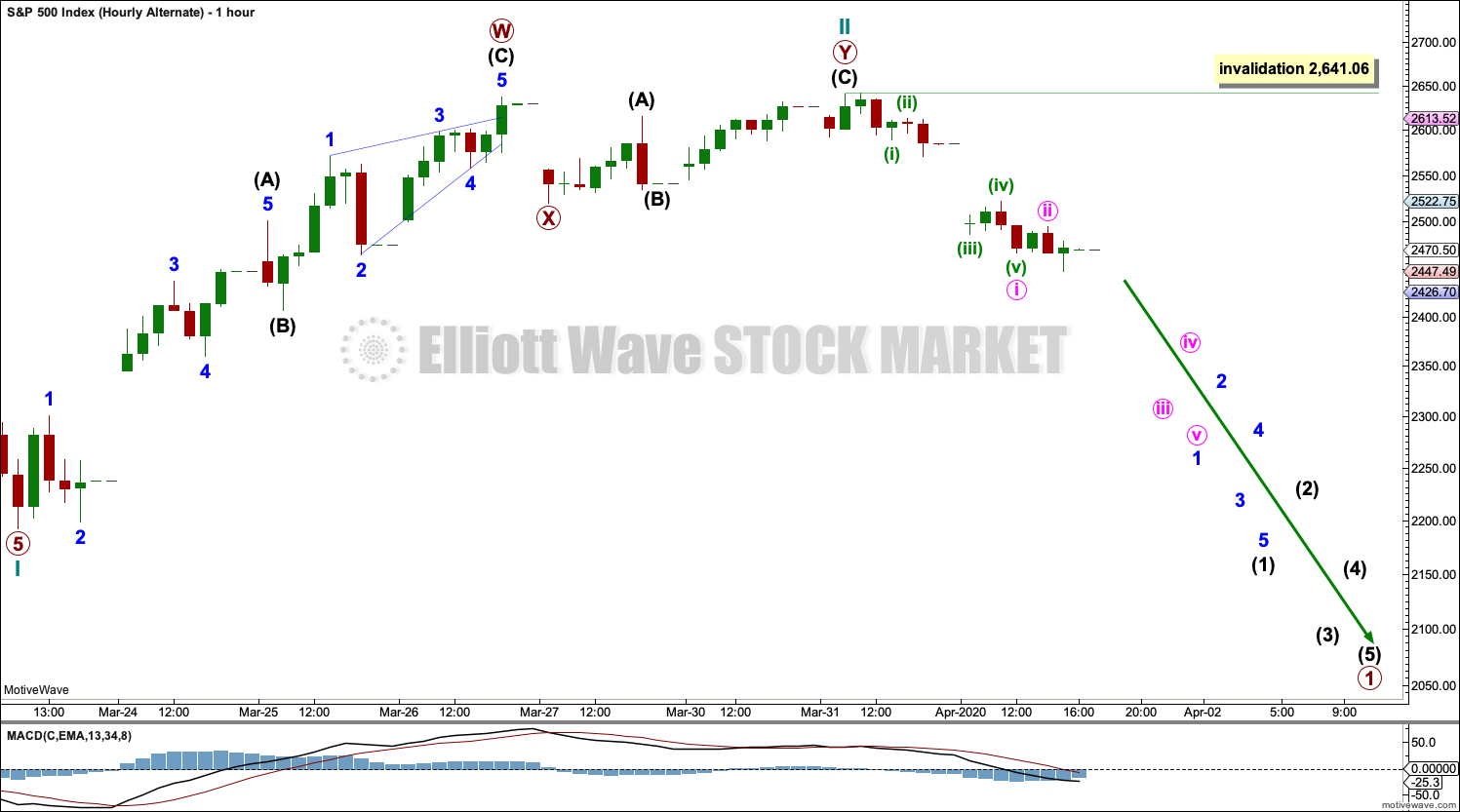S&P 500: Elliott Wave and Technical Analysis | Charts – April 1, 2020
Summary: A correction may continue this week and possibly into next week. It may be shallow if it continues to find resistance at the lower edge of the multi-year channel. A target for it to end is about 2,651.
Thereafter, the downwards trend may resume with strength.
Alternatively, it is possible that the correction is over although this has a lower probability. This possibility is outlined in the second hourly chart below.
The biggest picture, Grand Super Cycle analysis, is here.
Last monthly charts are here. Video is here. Members are encouraged to view all three monthly charts. The third is much more bearish than this main wave count and remains a valid possibility.
ELLIOTT WAVE COUNTS
WEEKLY CHART
The channel is now breached by a full weekly candlestick below and not touching the lower edge. Further confidence in this wave count may be had. The lower edge of this channel is continuing so far to provide resistance.
Price is now below the 0.382 Fibonacci ratio of cycle wave I at 2,352. The structure of cycle wave II may need further to go to complete. The next Fibonacci ratio at 0.618 is now a preferred target for cycle wave II to end.
Cycle wave II would most likely subdivide as a zigzag; thus far that looks like what it is unfolding. When primary waves A and B may both be complete, then the target may be calculated using a Fibonacci ratio between primary waves A and C. At that stage, the final target may change or widen to a zone.
Cycle wave II may not move beyond the start of cycle wave I below 666.79.
DAILY CHART
Draw the wide maroon trend channel carefully: draw the first trend line from the end of primary wave 1 at 2,093.55 (December 26, 2014), to the end of primary wave 3 at 2,940.91 (September 21, 2018), then place a parallel copy on the end of primary wave 2 at 1,810.10 (February 11, 2016). The channel is fully breached indicating a trend change from the multi-year bull trend to a new bear trend. The lower edge may now be an important line of resistance. If resistance at this line holds, then primary wave B may end close to the 0.382 Fibonacci ratio of primary wave A at 2,651.
Cycle wave II may subdivide as any Elliott wave corrective structure except a triangle. It would most likely be a zigzag. Primary wave A may be a complete five wave impulse. Primary wave B may not move beyond the start of primary wave A above 3,393.52.
HOURLY CHART
If the upwards wave labelled intermediate wave (A) is correctly labelled as a double zigzag, then primary wave B may not be subdividing as a zigzag or a double combination. A zigzag requires intermediate wave (A) to subdivide as a five wave structure. The upwards wave labelled intermediate wave (A) may not be labelled intermediate wave (W) as the first structure in a double combination, because waves W, Y (and Z if there is one) may only subdivide as simple corrective structures (not multiples).
If the upwards wave labelled intermediate wave (A) is correctly labelled as a double zigzag, then primary wave B may only be subdividing as either a flat correction or a triangle.
If primary wave B subdivides as a flat correction, then within it intermediate wave (A) may be complete as a double zigzag. Intermediate wave (B) would need to retrace a minimum 0.9 length of intermediate wave (A). Intermediate wave (B) may make a new low below the start of intermediate wave (A) at 2,191.86 as in an expanded flat. There is no lower invalidation point.
If primary wave B subdivides as a triangle, then within it intermediate wave (A) may be complete as a double zigzag. Intermediate wave (B) has no minimum required length to intermediate wave (A). Intermediate wave (B) may make a new low below the start of intermediate wave (A) at 2,191.86 as in a running triangle. There is no lower invalidation point.
Intermediate wave (B) may be subdividing as a zigzag. Within the zigzag, no second wave correction nor B wave may move beyond its start above 2,641.39.
SECOND HOURLY CHART
By moving the degree of labelling within primary wave B up one, it is possible that it could be over as a brief and shallow double zigzag.
The brevity of this wave count reduces the probability.
A new target is calculated for primary wave C to end.
ALTERNATE DAILY CHART
This alternate daily chart follows the Second Alternate Monthly chart published here. Video is here.
By simply moving the degree of labelling in the bull market beginning March 2009 up one degree, it is possible that a Grand Super Cycle trend change occurred on the February 19, 2020.
A correction at Grand Super Cycle degree may be expected to last at least a decade, possibly longer. Corrections for this market tend to be much quicker than bullish moves, and so a fair amount of flexibility is required in expectations for duration of the different degrees.
Grand Super Cycle II would most likely subdivide as a zigzag, although it may be any corrective structure except a triangle. It should begin with a five down at the weekly chart time frame, which would be incomplete.
The first five down on the daily chart is labelled cycle wave I. If this degree of labelling is wrong, it may be too high; it may need to be moved down one degree.
Following cycle wave I, cycle wave II may be complete as a relatively brief and shallow double zigzag. If it continues further as a flat correction, then cycle wave II may not move beyond the start of cycle wave I above 3,393.52.
A target is calculated for cycle wave III to end based upon a common Fibonacci ratio to cycle wave I.
ALTERNATE HOURLY CHART
Cycle wave II may be a completed double zigzag. Cycle wave III may have begun. Within cycle wave III, no second wave correction may move beyond its start above 2,641.06.
TECHNICAL ANALYSIS
WEEKLY CHART
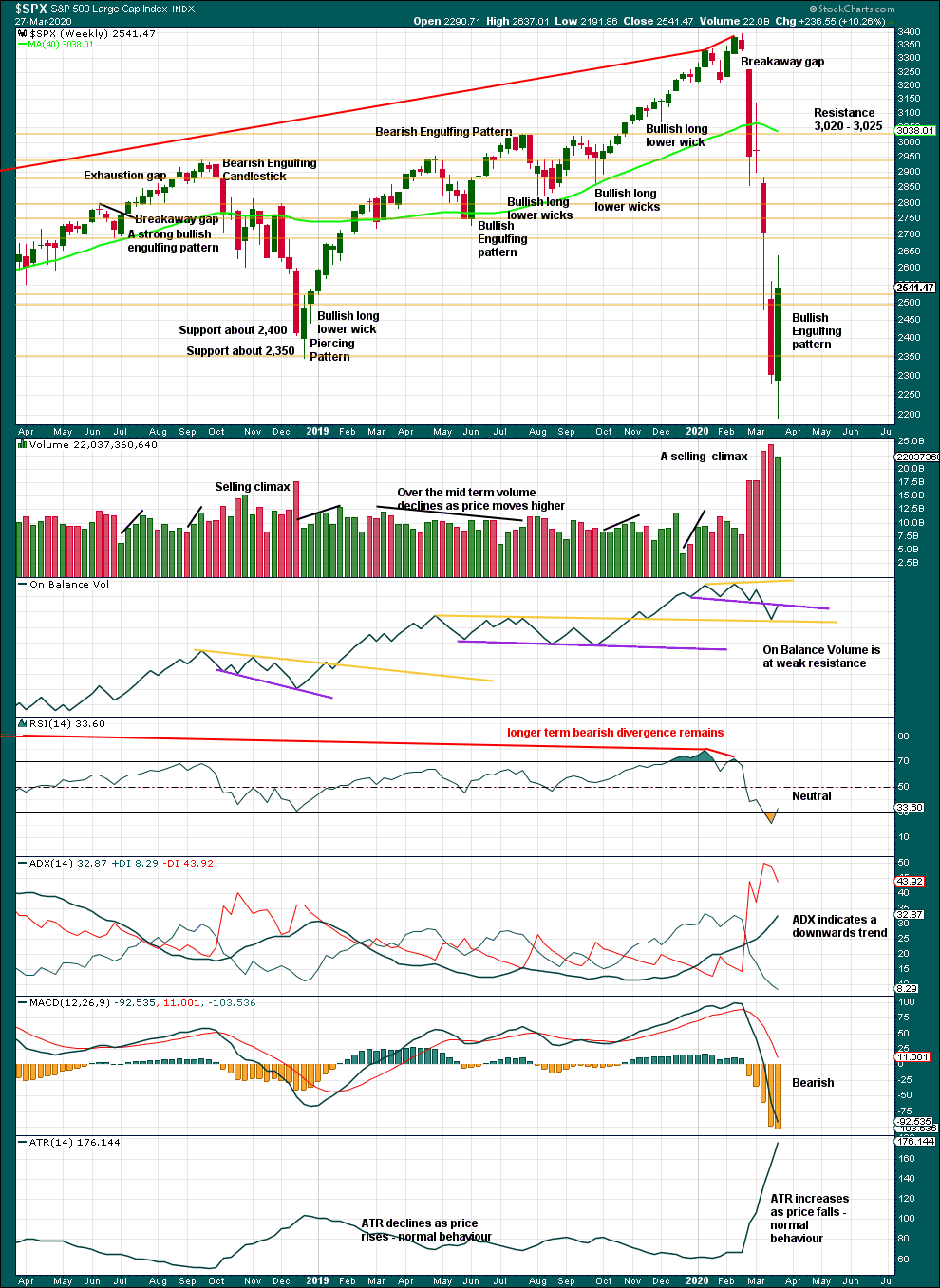
Click chart to enlarge. Chart courtesy of StockCharts.com.
A bounce has arrived within the bear market. It may continue further.
DAILY CHART
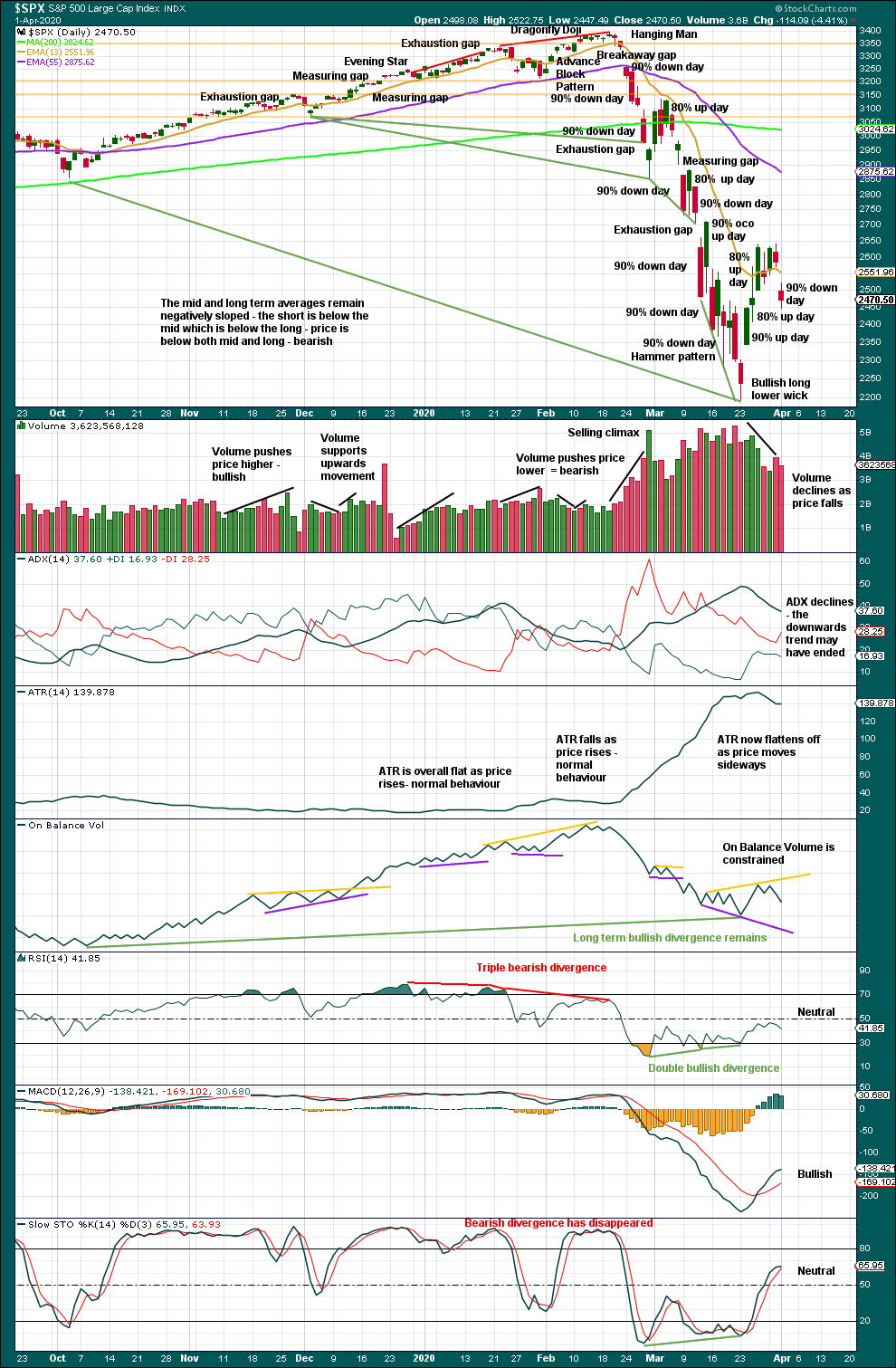
Click chart to enlarge. Chart courtesy of StockCharts.com.
Another 90% downwards day today indicates it is most likely that the bear market is incomplete. It would be highly unusual to see a 90% downwards day so close to a sustainable low.
Reduced range and volume today suggest that this session may be part of a consolidation or counter trend movement, and not necessarily the start of the next wave down. There is further room for this bounce to continue. RSI is below 50, there is no bearish reversal pattern at the last swing high, and this bounce has lasted only 7 days so far.
To see what signals may be looked for to identify a high, the two previous large bear markets will be analysed in end of week analysis. The DotCom crash was analysed last week here with video here.
BREADTH – AD LINE
WEEKLY CHART
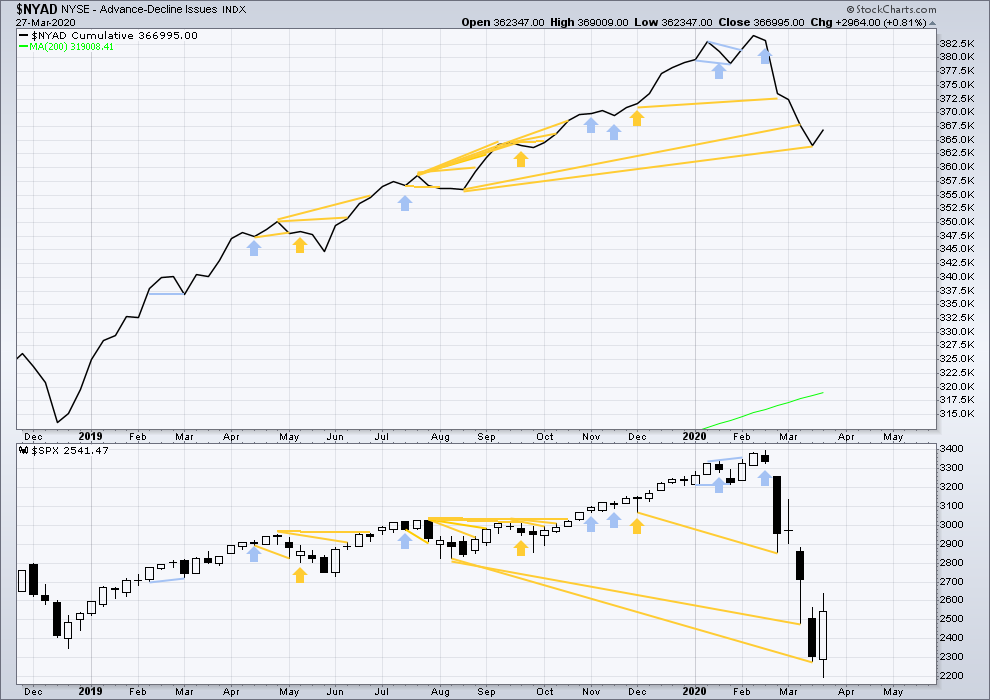
Click chart to enlarge. Chart courtesy of StockCharts.com. So that colour blind members are included, bearish signals will be noted with blue and bullish signals with yellow.
Bear markets from the Great Depression and onwards have been preceded by an average minimum of 4 months divergence between price and the AD line with only two exceptions in 1946 and 1976. With no divergence between the AD line and price at the last all time high, this current bear market now makes a third exception.
In all bear markets in the last 90 years there is some positive correlation (0.6022) between the length of bearish divergence and the depth of the following bear market. No to little divergence is correlated with more shallow bear markets. Longer divergence is correlated with deeper bear markets.
This bear market comes after no bearish divergence. It would more likely be shallow, but this is a statement of probability and not certainty. So far it is slightly more than the 0.382 Fibonacci ratio of the bull market it is correcting (beginning March 2009).
Last week an outside week closes green and the AD line supports upwards movement within the week. There is no new divergence.
Large caps all time high: 3,393.52 on 19th February 2020.
Mid caps all time high: 2,109.43 on 20th February 2020.
Small caps all time high: 1,100.58 on 27th August 2018.
DAILY CHART
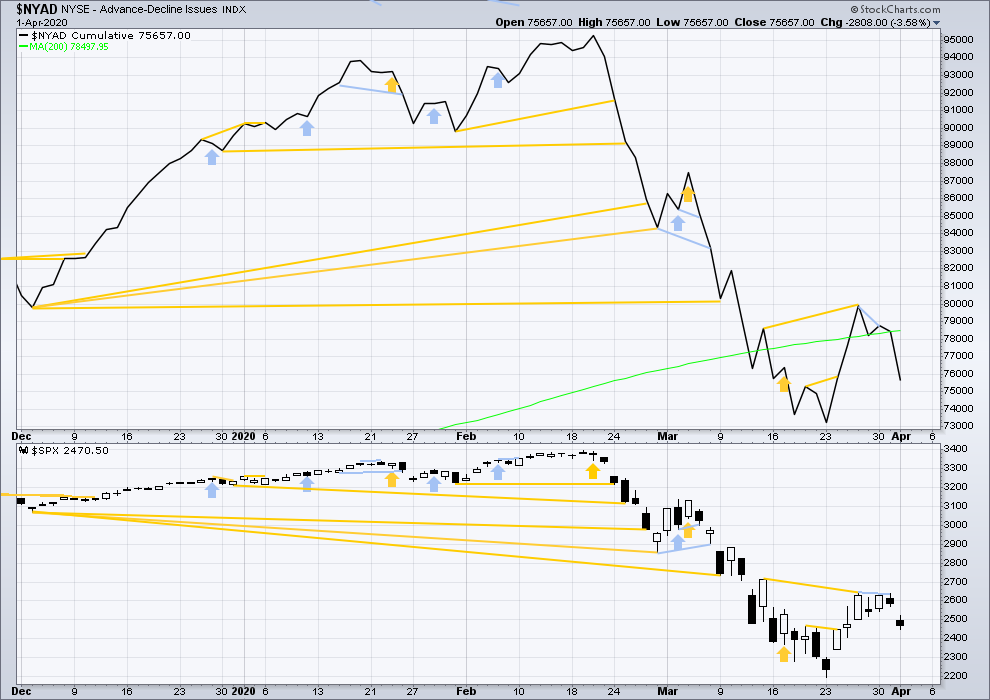
Click chart to enlarge. Chart courtesy of StockCharts.com. So that colour blind members are included, bearish signals will be noted with blue and bullish signals with yellow.
Breadth should be read as a leading indicator.
Weak bearish divergence noted yesterday has been followed by downwards movement. Today both price and the AD line have declined. Downwards movement has support from falling market breadth. There is no new short-term divergence.
VOLATILITY – INVERTED VIX CHART
WEEKLY CHART
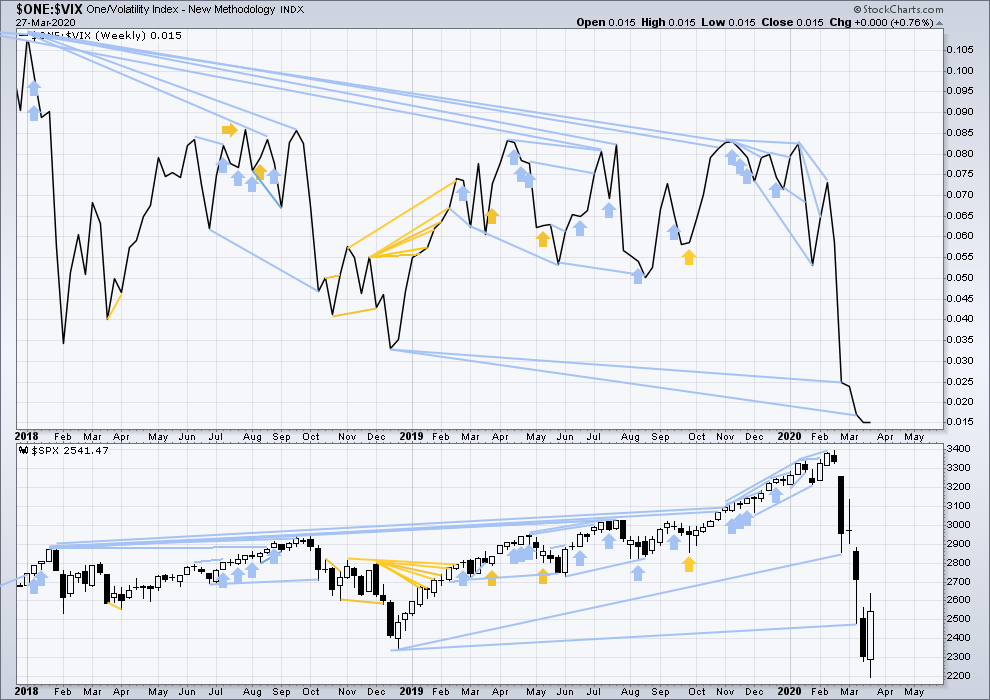
Click chart to enlarge. Chart courtesy of StockCharts.com. So that colour blind members are included, bearish signals will be noted with blue and bullish signals with yellow.
Last week completes an outside week, which has closed green, and inverted VIX is overall flat. There is no new short-term divergence.
DAILY CHART
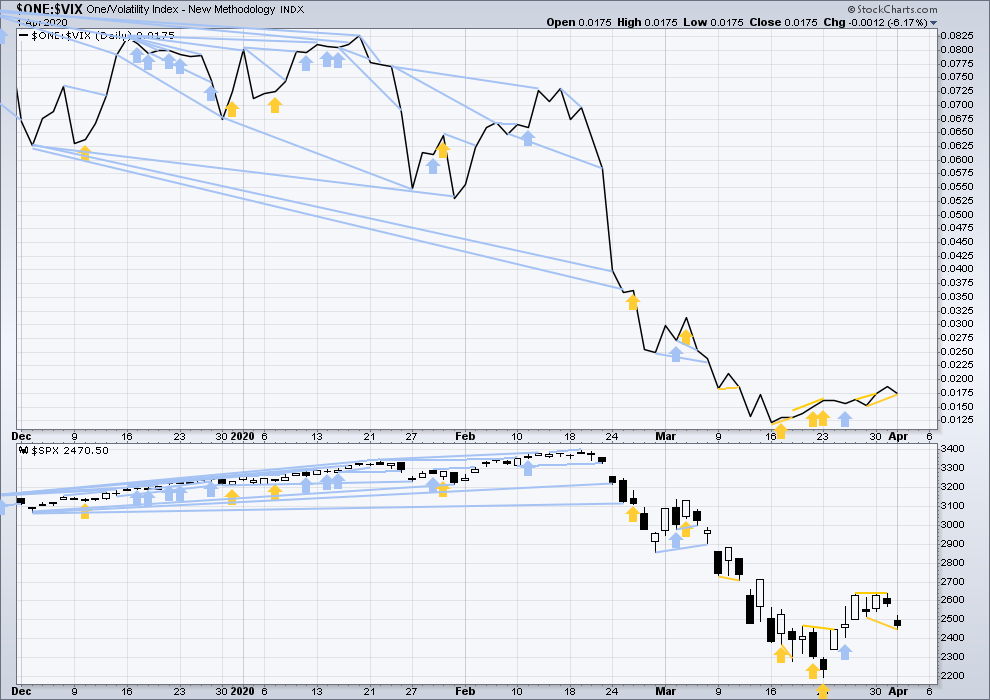
Click chart to enlarge. Chart courtesy of StockCharts.com. So that colour blind members are included, bearish signals will be noted with blue and bullish signals with yellow.
Both price and inverted VIX today have declined, but price has made a new low below the prior low of the 27th of March where inverted VIX has not. This divergence is bullish for the short term.
DOW THEORY
Dow Theory has confirmed a bear market with the following lows made on a closing basis:
DJIA: 21,712.53 – a close below this point has been made on the March 12, 2020.
DJT: 8,636.79 – a close below this point has been made on March 9, 2020.
Adding in the S&P and Nasdaq for an extended Dow Theory, a bear market has now been confirmed:
S&P500: 2,346.58 – a close below this point has now been made on March 20, 2020.
Nasdaq: 7,292.22 – a close below this point was made on the March 12, 2020.
Published @ 07:46 p.m. EST.
—
Careful risk management protects your trading account(s).
Follow my two Golden Rules:
1. Always trade with stops.
2. Risk only 1-5% of equity on any one trade.
—
New updates to this analysis are in bold.

